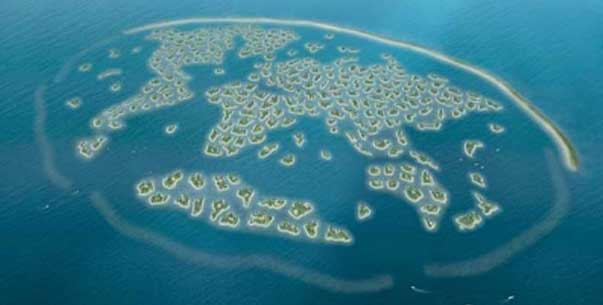|
|
the price of the world
several NGOs tell ascent what they would do with 1.8 billion dollars

In the epilogue for ascent 33, we looked at the price of “the world.” A luxury real estate development called The World is under construction off the coast of Dubai. The collection of 300 human-made islands, arranged to replicate the continents of the world, is estimated to cost $1.8 billion US. It would seem that such a substantial sum of money could be used to support many inhabitants of the real world in more profound and effective ways. ascent asked some global non-profit organizations what they could do with $1.8 billion US.
Dave Irvine-Halliday, Founder, Light Up the World
As lighting, literacy and economic development are very closely interrelated we would invest $1.5 Billion in microcredit, which would light 15 million homes (90 million people) in first year. The 1.6 billion people presently without electricity would light their own homes in less than 15 years, with billions remaining in bank! $250 million invested in companies to manufacture Solid State Lighting systems to create local employment and wealth. $50 million would be invested in the developing world through market studies, solid state lighting, renewable energy hardware and government energy policies.
Light Up the World is an international humanitarian organization dedicated to bringing affordable, efficient and environmentally responsible lighting to people currently without access. Since its inception ten years ago, LUTW has lit up more than 14,000 homes in 42 countries.
www.lutw.org
Lopa Das, President, Montreal branch of the Ashraya Initiative for Children
With $1.8 billion dollars, we could give all street children in the Indian cities of Bombay and Pune the opportunity to receive a high school education by covering their school fees, books and uniforms. We would also be able to give each child one healthy meal per day, and provide him or her with the opportunity to lead a happy and fulfilling life.
Founded in 2004 by seven college students, the Ashraya Initiative for Children is a home for street children in Pune, India.
www.ashrayainitiative.org
John Wood, Co-founder, Room to Read
We can set up and run a bilingual rural library in the developing world for $3000 US. This includes getting shelves, desks, chairs, and a bilingual collection of books, plus training for the librarian. With $1.8 billion, we could set up 600,000 rural libraries. Since each library serves, on average, 400 children, the investment would allow us to bring the lifelong gift of education to over 200 million children across the developing world. This is a substantial portion of the 770 million people in the world today who are illiterate.
Room to Read partners with local communities throughout the developing world to establish schools, libraries and other educational infrastructure.
www.roomtoread.org
Penny Lyon, Executive Director, Seva International
$1.8 billion could restore sight to 18 million blind children, men and women: roughly half of the world’s blind. However, this is a short-term solution. With this money, Seva could help create thousands of community ophthalmology programs throughout the developing world.
These programs would train local eye-care specialists to provide long-term, sustainable eye care for millions, ultimately even billions.
Founded in 1978, Seva serves people around the world who are struggling for health, cultural survival and sustainable communities. www.seva.org
Climate & Energy Campaign, Greenpeace
$1.8 billion could install more than 1000 wind turbines, with a total output of 1300 MW, generating 15 billion kWh, which is enough to supply 5 million European households (or 15 million people) with electricity, which would save approx 9 million tonnes of CO2 per year. (This amount of emission is approximately what is input in the atmosphere in one year by countries such as Luxembourg, Guatemala, or Kenya.)
Since 1971 Greenpeace focuses on the most crucial worldwide threats to our planet’s biodiversity and environment. www.greenpeace.org
|